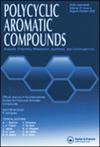酸枣仁中的植物化合物对肺癌靶蛋白的抗癌潜力:硅学验证
IF 2.4
3区 化学
Q2 CHEMISTRY, ORGANIC
引用次数: 0
摘要
酸枣属于鼠李科植物,主要生长在欧洲、亚洲南部和东部以及澳大利亚。最近对植物进行的植物化学调查提供了一些有关其生物效应的信息,如保护肝脏、免疫刺激、抗肥胖、抗炎和抗癌特性。目前的研究调查了 34 种来自竹叶青的植物化合物和三种针对三种肺癌靶蛋白的抗癌药物。药物相似性筛选结果表明,十二酸和 7,9- 二叔丁基-1-氧杂螺[4,5]癸-6,9-二烯-2,8-二酮这两种化合物对五种药物规则的违反率为零,壬二酸化合物对五种药物规则的违反率为零。分子对接研究显示,34 种植物化合物和 3 种抗癌药物针对 3 种重要的肺癌靶蛋白的对接分值范围分别为 -3.9 至 -10.2 kcal/mol 和 -7.2 至 -9.0 kcal/mol。此外,还对三种植物化合物坎贝斯特醇、柱头甾-5-烯-3-醇、7,9-二叔丁基-1-氧杂螺[4,5]癸-6,9-二烯-2,8-二酮和三种抗癌药物依托泊苷、紫杉醇和多柔比星进行了硅学筛选。三种植物化合物的药代动力学特征表明,它们的吸收、分布、代谢、排泄和毒性特征均优于标准药物。此外,生物活性和密度泛函理论分析表明,与标准药物相比,竹叶青的植物化合物具有更好的生物活性评分和分子静电位。分子动力学模拟结果表明,莰烯醇与 CDK2(PDB ID 1GII)和 MDM2/P53 (4HFZ)靶蛋白的模拟轨迹和结合亲和力均优于标准药物。我们需要对化合物(坎贝酯醇、石杉碱甲-5-烯-3-醇、7,9-二叔丁基-1-氧杂螺[4,5]癸-6,9-二烯-2,8-二酮)进行进一步的临床试验,以检验其与肺癌靶蛋白的临床相关性,从而将这些新型药物分子商业化。本文章由计算机程序翻译,如有差异,请以英文原文为准。
Anti-Cancer Potential of Phytocompounds from Ziziphus jujuba against Lung Cancer Target Proteins: An In Silico Validation
Ziziphus jujuba plant belongs to Rhamnaceous family and grows mainly in Europe, southern and eastern Asia, and Australia. Recent phytochemical investigation of plants provided some information on their biological effects, such as the hepatoprotective, immunostimulating, anti-obesity, anti-inflammatory, and anti-cancer properties. The current study investigated 34 phytocompounds from Z. jujuba and three anti-cancer drugs against three lung cancer target proteins. Drug likeliness screening revealed that two compounds dodecanoic acid and 7,9-di-tert-butyl-1-oxaspiro[4,5]deca-6,9-diene-2,8-dione possess zero violation, and compound azelaic acid possesses single violation against five drug rules. Molecular docking study reveals that 34 phytocompounds from Z. jujuba and three anti-cancer drugs showed docking score values in the range of −3.9 to −10.2 kcal/mol and −7.2 to −9.0 kcal/mol against three significant lung cancer target proteins. Furthermore, in silico screening top scored three phytocompounds campesterol, stigmast-5-en-3-ol, 7,9-di-tert-butyl-1-oxaspiro[4,5]deca-6,9-diene-2,8-dione and three anti-cancer drugs etoposide, paclitaxel, and doxorubicin utilized. Pharmacokinetic profile of three phytocompounds from Z. jujuba showed excellent absorption, distribution, metabolism, excretion, and toxicity profile than standard drugs. Furthermore, bioactivity and density functional theory analysis showed that phytocompounds from Z. jujuba possess better bioactivity scores and molecular electrostatic potentials than standard drugs. Molecular dynamics simulation results revealed that campesterol with CDK2 (PDB ID 1GII) and MDM2/P53 (4HFZ) target proteins possess better simulation trajectories and binding affinity than standard drugs. Further clinical trials of compounds (campesterol, stigmast-5-en-3-ol, 7,9-di-tert-butyl-1-oxaspiro[4,5]deca-6,9-diene-2,8-dione) are needed to check clinical pertinence toward lung cancer target proteins to commercialize these novel drug molecule in the drug industry.
求助全文
通过发布文献求助,成功后即可免费获取论文全文。
去求助
来源期刊

Polycyclic Aromatic Compounds
化学-有机化学
CiteScore
3.70
自引率
20.80%
发文量
412
审稿时长
3 months
期刊介绍:
The purpose of Polycyclic Aromatic Compounds is to provide an international and interdisciplinary forum for all aspects of research related to polycyclic aromatic compounds (PAC). Topics range from fundamental research in chemistry (including synthetic and theoretical chemistry) and physics (including astrophysics), as well as thermodynamics, spectroscopy, analytical methods, and biology to applied studies in environmental science, biochemistry, toxicology, and industry. Polycyclic Aromatic Compounds has an outstanding Editorial Board and offers a rapid and efficient peer review process, as well as a flexible open access policy.
 求助内容:
求助内容: 应助结果提醒方式:
应助结果提醒方式:


